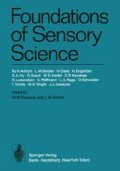Abstract
I began my career in vision as a graduate student in psychology (1929–1932) under William McDougall, who introduced me to the problems of binocular fusion and rivalry. In learning to paint, I had already encountered the problems of stereopsis and space perception. In my home was a stereoscope and a set of cards. Just a few years before in 1924, Southall had completed the translation of von Helmholtz’s (1924) A Treatise on Physiological Optics. The volumes of the Treatise were high on my reading list.
Access this chapter
Tax calculation will be finalised at checkout
Purchases are for personal use only
Preview
Unable to display preview. Download preview PDF.
References
Names containing von are alphabetized in this list under v
Ames A, Ogle KN, Gliddon GH (1932) Corresponding retinal points, the horopter and size and shape of ocular images. J Opt Soc Am 22:538–631
Bailey NJ (1954) Determination of the location of the center, or centers, of projection in anomalous correspondence. PhD dissertation, Ohio State University
Boegehold H (1935) Doppeltorische Linsen ohne Astigmatismus. Z Ophthalm Optik 23:41–55
Bridgman CS, Smith KU (1945) Bilateral neural integration in visual perception after section of the corpus callosum. J Comp Neurol 83:57–68
Burian HM (1948) The history of the Dartmouth Eye Institute. Arch Ophthalmol 40:163–175
Burian HM (1974) The Dartmouth Eye Institute. Survey of Ophthalmol 19:101–106
Dawson S (1917) The theory of binocular color mixture. Br J Psychol 8:510–551
Duke-Elder S (1934) Text-book of ophthalmology, vol I. Mosby, St. Louis
Edridge-Green FW (1920) The physiology of vision. Bell, London
Fry GA (1936a) The binocular integration of hue and brilliance. Arch Ophthalmol 15:443–456
Fry GA (1936b) The relation of accommodation to the suppression of vision in one eye. Am J Ophthalmol 19:135–138
Fry GA (1940) Orthoptic procedure with the royal rotoscope, Chapt 1–12. The Wottring Instrument Co, Columbus, Ohio
Fry GA (1941a) Class notes on binocular sensory mechanisms. College of Optometry, The Ohio State University
Fry GA (1941b) Class notes on visual perception. College of Optometry, The Ohio State University
Fry GA (1944) The measurement of the threshold of stereopsis. Optom Wkly 33:1029–1032
Fry GA (1950) Visual perception of space. Am J Optom 27:531–553
Fry GA (1956a) The discrepancy between physical and perceived curvature. Am J Optom Arch Am Acad Optom 33:147–154
Fry GA (1956b) The relation between perceived size and perceived distance in the periphery. Am J Optom Arch Am Acad Optom 33:477–482
Fry GA (1962) Eye-body coordination in the perception of space. In: Transactions of the International Optical Congress. Crosby Lockwood, London, pp 16–33
Fry GA (1972) Reversible stereopsis. Optom Wkly 63:300–302
Fry GA, Bartley SH (1933) The brilliance of an object seen binocularly. Am J Ophthalmol 16:687–693
Fry GA, Treleaven CL, Baxter RC (1945) Specification of the direction of regard. Special report No. 1. Committee on nomenclature and standards. Am J Optom Arch Am Acad Optom 22:351–360
Hecht S (1928) On the binocular fusion of colors and its relation to theories of color vision. Proc Natl Acad Sci USA 14:237–241
Howard HJ (1919) A test for the judgment of distance. Am J Ophthalmol 2:656–675
McDougall W (1910) On the relation between corresponding points of the two retinae. Brain 33:371–388
Mitchell DE, Blakemore C (1970) Binocular depth perception and the corpus callosum. Vision Res 10:49–53
Müller J (1826) Zur vergleichenden Physiologie des Gesichtssinnes des Menschen und der Tiere. Cnobloch, Leipzig
Ogle KN (1950) Binocular vision. Saunders, Philadelphia
Ogle KN (1962) The optical space sense. In: Davson H (ed) The eye, vol 3. Academic, New York
Panum PL (1858) Untersuchungen über das Sehen mit zwei Augen. Schwers, Kiel
Panum PL (1861) Über die einheitliche Verschmelzung verschiedenartiger Netzhauteindrücke beim Sehen mit zwei Augen. Physiol 63–111, 178–227
Sherrington CS (1906) The integrative action of the nervous system. Yale University Press, New Haven
Trendelenburg W (1923) Weitere Versuche über binokulare Mischung von Spektralstrahlen. Arch Gesamte Physiol 201:235–246
Verhoeff FH (1902) A theory of binocular perspective. Annals of Ophthalmol 11:201–229
Vieth GVA (1818) Über die Richtung der Augen. Ann Phys (Leipzig) 58:233–253
von Helmholtz H (1924) A treatise on physiological optics. Optical Society of America, Rochester
von Rohr M, Boegehold H (1934) Das Brillenglas als optisches Instrument. Springer, Berlin, S. 113–121
Editor information
Editors and Affiliations
Rights and permissions
Copyright information
© 1984 Springer-Verlag Berlin Heidelberg
About this chapter
Cite this chapter
Fry, G.A. (1984). Binocular Vision. In: Dawson, W.W., Enoch, J.M. (eds) Foundations of Sensory Science. Springer, Berlin, Heidelberg. https://doi.org/10.1007/978-3-642-69425-7_8
Download citation
DOI: https://doi.org/10.1007/978-3-642-69425-7_8
Publisher Name: Springer, Berlin, Heidelberg
Print ISBN: 978-3-642-69427-1
Online ISBN: 978-3-642-69425-7
eBook Packages: Springer Book Archive

